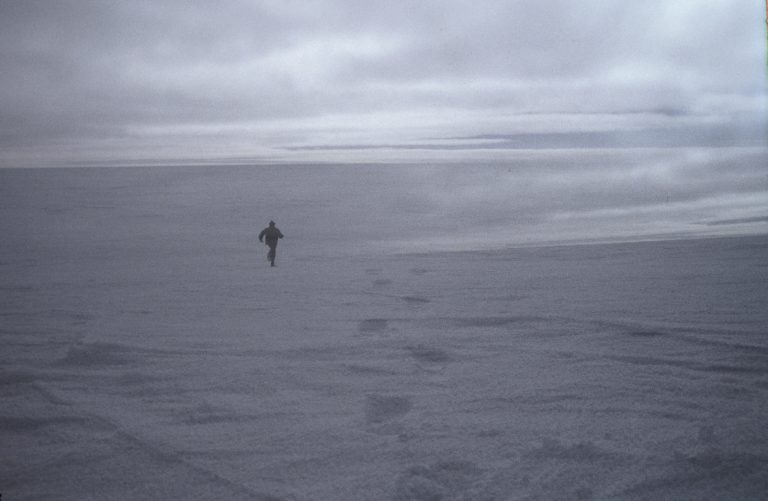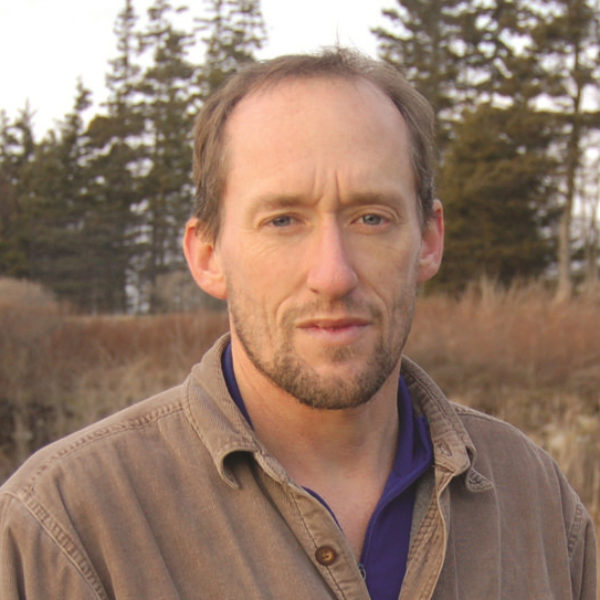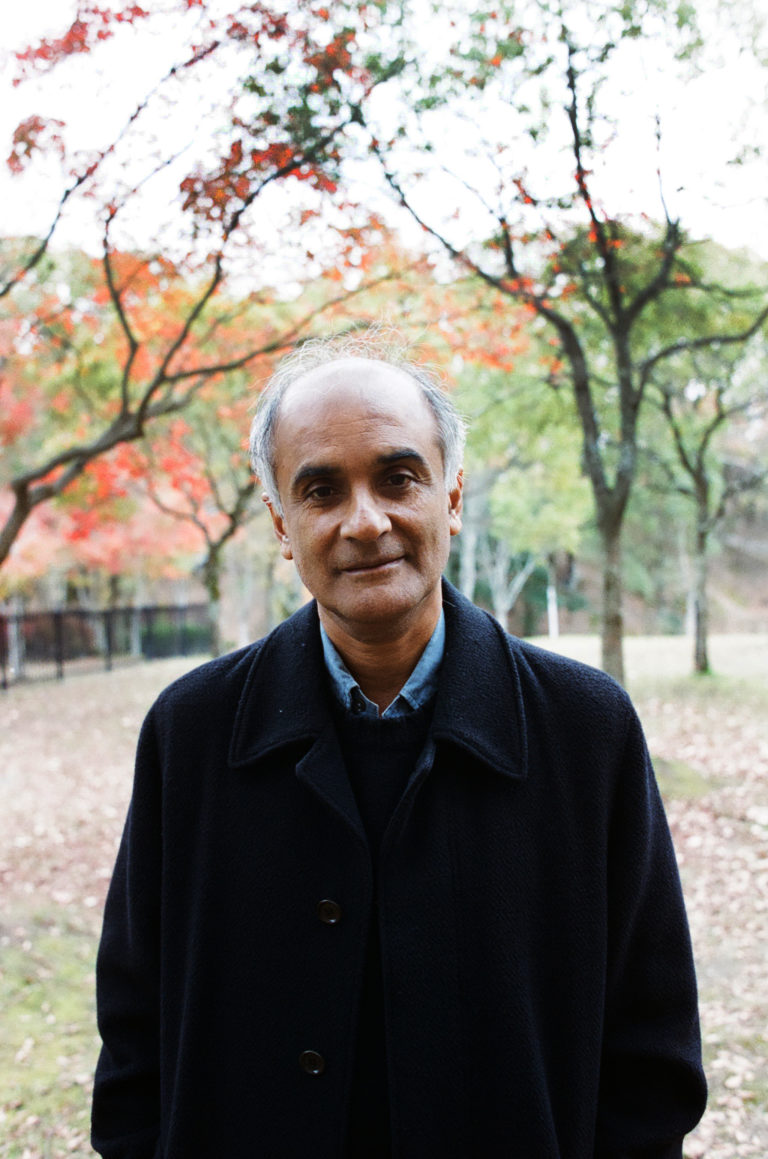
The East Antarctic and the Emptiness Within
Beyond the penguins and icebergs, far behind the stony coast, larger than the United States and deprived of life, is the East Antarctic ice cap. This blank space is the vast bulk of the southern continent, a world of ice inconceivable to anyone who has not traveled over its emptiness.
Hours are spent flying over a small portion of an undifferentiated white icescape. Ice, up to three miles deep, swells up from a drowned continent and overflows its several thousand miles of coastline. Nothing interrupts the blank face of the interior except a few research stations and a handful of temporary camps set up each Antarctic summer. As I found in eight seasons of Antarctic work, to meet this place on its own terms is to begin a dialogue with perception. The ice cap challenges our notions of place and self.
Antarctica is the aesthetic ledge from which we leap into space, the antibiotic portal to all that nothing we cannot conceive. A serengeti of snow-dressed ice rejects life across its millions of square miles. From our cluster of tents we touch great emptiness and greater cold with naked lungs and hands, something no astronaut or cosmonaut can do.
What do we understand about the essential Antarctic, this interior emptiness? What notions and emotions survive the context of this icescape with its funereal cold?
Here, as elsewhere, science makes thin reams of data, numbers in streams to be set aside for analysis. We cultivate absences, especially here in the great frozen petri dish of the ice. Antarctica is the meditative white gate to all the darkness we cannot know. We don’t understand this local quietus, much less the black universe beyond it, but here we go.
Is it possible for one imagination to explain the Antarctic interior? Here are countless variations of a frozen limbo in the form of a white-on-white desert. Here is silence practicing scales under its breath. A newly-introduced mind, eclipsed, sees all this in an instant.
But will familiarity teach me to classify the undulations of ice under a blank sky? At what point does one person fail to maintain the awesome singularity of it, the wonder of standing on the wide white cusp between life and space?
This is where the “dialectic between idea and ice” takes place. Do I fail if I speak only to the variations, or do I fail if I romance the monotony?
The air is eternal, pre-existence. The scene is pre-human, post-human, a spiritual plane unidentifiable with faith or culture. What we see here is what we cannot know, and what we know is what we cannot see.

The emptiness is not coated with a single silence. Instead, it is littered with silences, the invisible rags of soundlessness that are blown about by the rough perpetual wind. When the wind stops, absences unfold over the desert snows. When I find myself wrapped up in one, I note that the continent’s blue lid has shut for a while, that things are hesitated, muffled.
Life in the clouds. The same vast white surface, the same rough impermanent ground, and the need within us to marvel at what mystery lies beneath the sameness.
No object here to alienate us, nor any sign that we are unified with this emptiness. If we find otherness in the ice at our feet, how do we cope with its scale? What do we do with a landscape that we call empty but is in fact an earth, an earth which is a monument to a cold unity that may not include us?
No landscape is more inexhaustible, less embraceable, than the Antarctic. Life is the drop of water running through the freezer.
Antarctica is the only major terra incognita ever discovered by Europeans. No native waited on the fast ice as the first wooden ships limped south. No culture predates us. The implications are both staggering and unrealized.
Neither material nor spiritual world waiting here for us. No gods to clash against each other, or to give us meaning as we struggle with the land. No supernatural for us in this proto-nature. No vertical axis in the human mind connecting underworld to skyworld. No cosmology, no fear, no epiphany, no genuflection. Scarcely four cardinal directions, and no natives to draw religion from the convex paths of the compass.
We newcomers are the parishioners, the altar, the material and spiritual elements. We are world and worldview.

No one has ever come to East Antarctica by accident. No one has ever stood on the ice cap intending to be somewhere else on earth. No one has ever arrived without intent.
A glacial continent moving outward from itself, out from the center with imperceptible but unstoppable momentum. Ice miles deep sloughs off at the edges what once joined at the center. A metaphor for transformation? Yes, though an impossible one. A spiritual guide? Perhaps: if we live to shed the excess of thoughts and feelings, shed them like an ascetic’s outer rags, and if we strive, however feebly, to make our selves expressionless and featureless, upon which the accretion of days means only an affirmation of the transience of things, then surely we approach in our person the lunacy of this place. Icebergs calve off in megatons what was gathered in milligrams…
Here is the Great White Buddha: the self’s migration in the wheeling of a translucent earth, the metamorphosis of a continental material that is both here and gone.
We are asking the question, and we are the answer. We are the question mark looking for enough words to prop us up.
The textures of the snow under the closest inspection by the naked eye are exactly the same as its textures when seen from the window of a plane. A scuffed whiteness, rich with erosion, like a bleached bone.
Now I know: white is blue. Antarctica is not white. Look closely at the snow at your feet, even more closely at the snow out beyond. Where I say white, think pale reflected grays and incremental blues. When you ask which blue, think bruise behind lace. When you think hue, think oblivion.
All we see is surface. What we say is white, a paper cloud.

An error on my part: nothing on the ice cap is “flat,” just as nothing is “white.” I can’t fail to recognize the infinite variation of the surfaces up here. There are countless textures, visible even in a short walk away from our little human operations. From small ridges the thickness of a fingernail to sastrugi like dolphins, the cold ground beneath us rises to meet the wind.
Sastrugi are the large-scale hard waves of snow that rise amidst a frozen ocean of ripples, lines, edges, ridges, lumps, slopes, pitches, and basins, making true flatness a rare island amid hard turbulence. Layers and textures are born from complexity: direction, speed, and duration of wind play their roles under variations in temperature, amount of available blowing snow, and the old surface features. It’s only our literary and conversational habit on the ice that describes a continental surface furrowed by wind as sheer and featureless.
In 1957, Paul Siple noticed in his survey of the area around the South Pole a pattern of extremely low rolling hills, “which reached crests 50 to 100 feet high every five or ten miles … and were apparently large-scale migrating snow dunes.” That’s only five to twenty feet of slope per mile.
Distractions and attractions are so absent in this icescape that our language responds with negation. We don’t see anything we know, so we say there’s nothing at all. Eventually, however, we must try to appreciate the infinitely complex and its relationship to the infinitesimal. Follow the erratic stitch at your feet, though it’s only several snowflakes high and doomed to be erased by the next gust.
Does the large-scale monotony or the small-scale variety capture the imagination? What scale feeds fear? Which feeds beauty? It takes minutes or years for these textures to form. When I say “flat” in this notebook, I’m thinking of a wilderness of minor textures, wind-driven, sculpted, in flux.

How do we respond to this nature? There is scarcely enough creation before us to imitate. What have we seen together and what social hope can be derived? We have already chosen to live in an alternative world just to see this place. We can try to amplify its emptiness, as this writing does, but I’m still not sure what there is to confirm.
The phenomenon of the ice cap does not offer glimpses of nature. Either you see nature exposed at its root, or you do not find it here at all. There is no middle ground. So it little matters that you observe the emptiness through the small window of a plane or the cramped door of your tent. As long as the intent to respond springs from the observation and not from the window itself, a fragment of nothing will serve as the whole, if we can only find a way to speak to it.
Look at the map. Don’t look at the coast, don’t look at the text. Just look at the white mass that is the Antarctic. Look at the nothing that fills the map.
Even mapmakers regard the white space as just white space. In atlases, they cover the ice over with paragraphs that describe a few famous journeys and a few famous facts about storm and cold. But under those words is a mute continent of ice, the essential Antarctic, that which estranges this enormous place from all others on Earth.
Interior Antarctica is a barrier that predates our species. And though we have crisscrossed and inhabited this harshest of all landscapes, the wall remains essentially intact, exactly because there are no walls. We bring our own (thin) walls and hide behind them. The ice is a mental barrier, a wall of indifference.
Incandescent, generous with light, even fulfilling? From the dust on the edge of the lit bulb we step up, shield our eyes, gaze inward.

Up in the air, a small speck in the blue, we sometimes sail over immense crevasse fields along the inside edge of the Transantarctics. Serpentine swaths of gigantic cracks shatter areas of many square miles, often with their snowbridges mostly intact. They look wide from 3000 feet up, wide enough to swallow ships. Many smaller crevasses run at right angles to the large ones, like a midwestern street map from hell. Route-finding on the ground would be impossible, and I imagine the early explorers wandering on foot or ski trapped in these purgatories. We fly over them in only a few minutes.
That I am free to imagine the early days of Antarctic exploration from my droning Olympian vantage point in a plane speaks volumes about our easy temporary invasions of the Antarctic interior. Though we cannot easily stay for long, people like me are free to teach ourselves to be expert at coming and going.

We navigate the somewhat circular Antarctic, especially its interior, precisely by imagining the continent as square. “Grid direction” was established back in 1957 during the scientific colonization of the Antarctic. Grid direction ignores Antarctica’s relation to the rest of the planet, and instead fabricates a grid much like the roads of a planned city. On aviation maps, this grid is superimposed over the ice. In this orientation, the South Pole is the central point. Grid North runs along the Greenwich meridian, while Grid South follows the International Date Line. The names West and East Antarctica indicate their direction from the Greenwich meridian.
The real geography is neither round nor square, and its qualities are infinite in their monotony. Our artificial constructions are both difficult to see on the ground and absolutely natural to our minds. Everything we say about the ice is part of the palace of consciousness that travels with us.
It’s all out there, just steps away. The impermanence is more present than I am. I, we, this sketched home of tents and flags, are desperately more impermanent than the hard silence. I didn’t get anywhere until I came home and looked back over my shoulder.
Our alienness is so obvious (even giraffes, loping away across the snows, would seem more native), our presence so tenuous, that our century-old foothold on the ice seems never to move beyond the first step of arrival.
What intimacy is possible with this place? Not as much as I feel. How much loneliness do I find in the icecape? Not as much as I feared. The proximity of my life to this lack of it, and the fact that my observations are altered by what objects I carry with me, contribute to the suspicion that I am scarcely here at all.
But I feel close to that which ignores me. I lay down upon it to sleep, surrounded by technology, but not so enclosed that the ends of my thoughts do not collide with the continental no-thought, which moves much closer to me if I feel insulated and alone.

If interior Antarctica has taught me anything about time, it’s that timelessness surrounds us in a life composed entirely of unframed moments. On the ice I feel no story, no beginning or end. Time is not the straight and shallow river I imported, but rather an invisible relation between things on a scale so large that my life and observations are immeasurably small. My moments don’t exist, and so are simultaneous, as it were, with the infinite. Some days this timelessness seems to crush in on me from all directions, while on others it feels like a medium through which my experience radiates out in all directions, without destination.
Antarctic summer is both the singular moment of high albedo, and an analogue for the endless horizon of time. Timelessness should pervade any description of Antarctic experience that also accounts for the relentless scale of the ice.
My conscious presence here does not overwhelm the awareness of deep time, as it does everywhere else. Here I am overwhelmed. This irrational experience of Antarctic time is the “native” experience, and the rational notions of mind and space which drive science have little to say about it, cannot recommend or obviate it.

The brief sweep of a zephyr of cold air across the ice is both the infinitesimal fingerprint of an instant and the breath of an ageless universe.
All things visible or invisible are connected, whether through time, space, or imagination. As we muddle through our days, however, we cultivate, or are cultivated by, the absences that are the shadows of consciousness: we measure the distances between all things, and between those things and us. When we take time to think about things we call “invisible” or “empty,” we make them visible to the mind, yet when we say little of something visible, we grow blind to it.
But out of the chaos of our perceptions certain depths emerge. As we experience a lifetime of finding connections, the perspective condenses: for me, space and time have begun to feel like different forms of imagination.
Each moment is a lifetime. Here, in this landscape that is also a blank continuum, every liminal day, there is a lesson in this understanding.
Now, at the end of our season on the ice, as we prepare to go back to what Antarctic residents, in unsure irony, often call the “real world,” where can we go that will not be touched by this empty unity?
At peace, I feel more antarctic than mindful, cultivating the silence that I remember so well. Within things and my thoughts is the landscape of quietude. I am the bridge between Antarctica, which is the bridge between space and the Earth, and my mind.
A version of this essay was originally published, in different form, in the Seneca Review.


Share your reflection